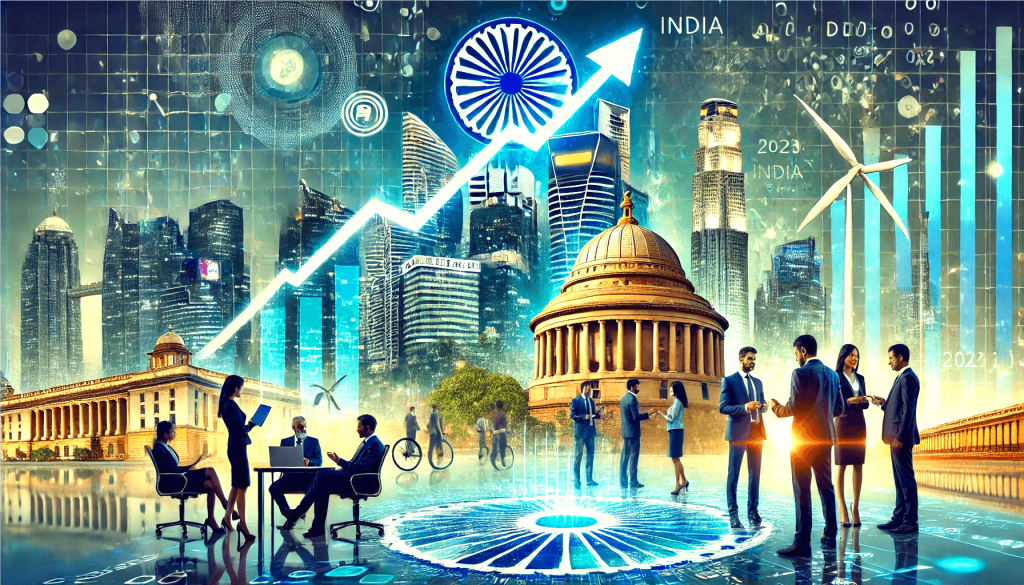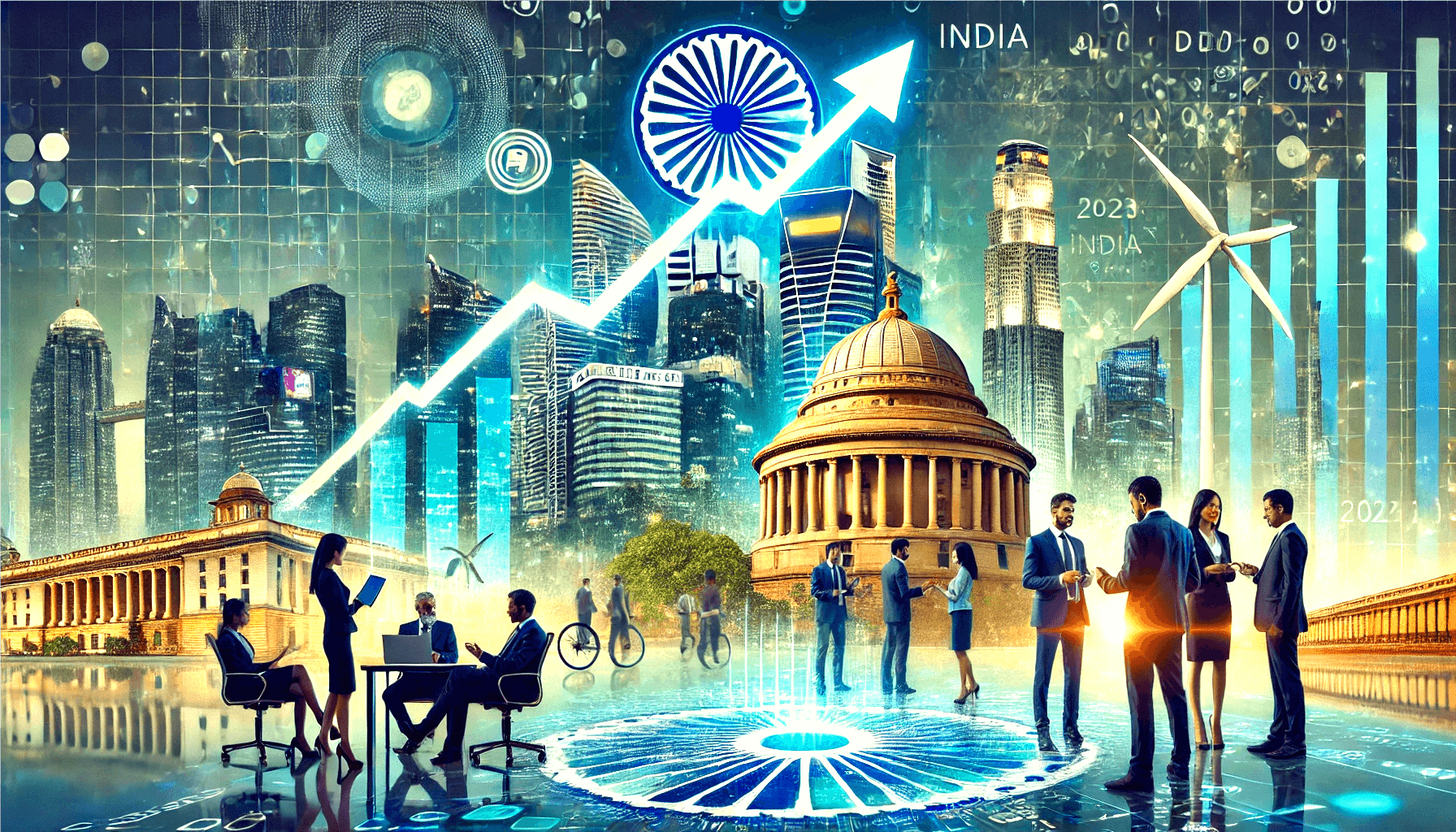Table of Contents
The Economic Survey of India in 2025, which Nirmala Sitharaman will present, attempts to address India’s payment balance situation, challenges it faces, and the anticipated result during the next fiscal year. Additionally, in the survey, the Chief Economic Survey Adviser’s concern regarding inflation, GDP, sectoral advancement, power budgeting, and his recommendations regarding construction and response management Lastly, focusing into the tracking system seeks alteration along with the response. addresses what he intends to change within the system along with a counter response.
GPD and Economic Growth Assessment
Compared to the previous fiscal of 2024-2025, the real domestic product growth during the current fiscal year of 2025 stands at six point four percent. This is one of the most outstanding features when looking at the current affairs. It is no surprise that, India, even during these times is one of the fastest growing economy of the world nd looking at the survey results the GDP growth rate for FY2026 is expected to get nestled between six point three and six point eight percent which is commendable. This growth is expected due to the strong domestic demand, infrastructural development and growth in industries.
Submitting trade disruption, geopolitical tension and changes in global commodity prices is inhibiting the overall optimism regarding India’s structural reform, digital transformation and the ease of doing business.
Inflation and Monetary Policy Developments
As mentioned in the survey, inflation is on a global decline primarily as a result of tightening bank measures, enhanced supply chain efficiency, and steadily priced food. The Reserve Bank Of India has a target of 4%. With the flickering projection of worsening global inflation, many central banks including India are deciding with quite a conformed agreeance to gradually increase policy rates in order to stimulate economic activity.
Internationally, the energy market risks supply inflation due to agricultural discontinuities, coupled with erratic weather changes. The survey exhibits other risks to remain as is. There’s a strong grasp the government holds on energy independence and food security, which should curb the risks we face.
Fiscal Deficits in Government Spending
The goal of achieving the fiscal deficit figure for the year 2024-25 comes somewhere within reach. The government targets a 5.8% deficit to GDP ratio which, given the past figures of the country, is a good target. The survey praises the holding back by the government in controlling expenditure but at the same time spending deliberately on certain activities such as infrastructure development expenditure.
Long term expenditure on transportation and digital infrastructure should strengthen the economy. Building roads, railways, ports, and renewable energy plants are of essential importance as it will provide employment opportunities, enhance productivity, and more importantly, grow the economy.
Broadening Local Involvement Together with Foreign Airlines
India’s attractiveness has grown for FDI with India receiving $55.6 Billion of FDI during FY2024-25. Improvement has been noted to be as a result of some change in policies which is a good sign, more relaxed, better PLI scheme, and the world looking for places to relocate manufacturing and expand the supply chain away from China.
In addition to Foreign Direct Investment, the report points out the contribution of Startups, MSMEs, and the digital economy towards employment creation and advances in technology. Business owners and creators have sought numerous advantages due to programs like Startup India, Make in India, and Digital India which are crucial for global competitiveness.
Rural Development and Agriculture
Exploring the Indian economy, the agriculture sector is of utmost importance. The reason is that nearly 42% of the Indian population and 17% of the GDP is generated from farming. The report does state there has been some progress regarding improvements in technology and policies for irrigation, exports, crops, and even agriculture as a whole.
Support measures such as PM-KISAN, e-NAM, and the Agri-Infrastructure Fund have provided stockholders with income support and access to the market. The worry is how global warming is causing the monsoons in India to become increasingly unpredictable and so there is a greater need for investment into techniques that focus on sustainable farming and precision agriculture.
Expansion In The Industry and Manufacturing
During this period, the activities of the industry have greatly improved as a result of the growth in the construction and manufacturing industries. These investments in the electronics and automobile industries as well as in the pharmaceuticals because of PLI schemes have broadened the scope and growth of production and employment.
Likewise, the survey reveals that there has been an increase in the consumption and export of automobiles, steel and textile industrials. This together with the application of AI in automation has resulted in the adoption of Industry 4.0 technologies and an increase in productivity.
Services Sector And The Digital Economy
At present, services sector is the major contributor across all industries within India, accounting to more than 55% of the GDP. IT & software services, fintech, tourism and e-commerce have become major engines of growth. As per the survey, India is the largest player of the digital economy as it excels in digital payments, AI analytics and cloud services.
With that in mind and the cultural tourism activities during the presidency of G20, it was thought that there will be magnified surge in tourism post-pandemic. It even recommends that accelerating heritage site development coupled with proliferation of visas would indeed expand tourism.
Policy Dilemmas And Suggestions
While looking at the India GDP predictions, it does look interesting. There are, operationally, some questions that the survey is trying to grapple with that seem to be impediments to progress which is sustainable.
Jobs and the Labor Market: The ongoing investment into business process automation plus AI technology means that there is a need to guide upskills and train the labor force, which is a downside for the employment market.
Environment And Climate Change: There is work to be done though: investment on renewable energy, sustainable spatial planning, and disaster risk mitigation.
Banking And Financial Development: More work can probably be done e.g. stimulating the economy through increased credit, and addressing the dismal volume of non-performing assets NPA’s.
Uncertainties In The Global Economy: The impact of external shocks could be mitigated through stronger trade diversification, greater self-reliance in some key sectors and mutual relations with other nations.
The survey suggests that in order to expand the economy, India should adopt policies that widen the digital gap and invest in increased infrastructure development.

Conclusion
In conclusion, the Annual India Economic Survey reveals invaluable insights about economic indicators and assets such as a growing GDP, insignificant inflation, active investment, and a high digital economy as a whole. No matter useful innovative policies are in place, the US’ infrastructural development combined with the national power is bound to propel India toward the highly anticipated ‘5 trillion dollar economy’ goal.
Given the sufficient focus on economic growth, innovation, and sustainability, the overall potential of the economy growth remains extremely promising so that India can become a global super power in the coming decades.
If you are interested for more: Salwan Momika 2025: The Pervasive Individual Condoning Freedom of Speech in Sweden India’s Economic Survey 2025: Promising Growth & Key Trends for the Future



